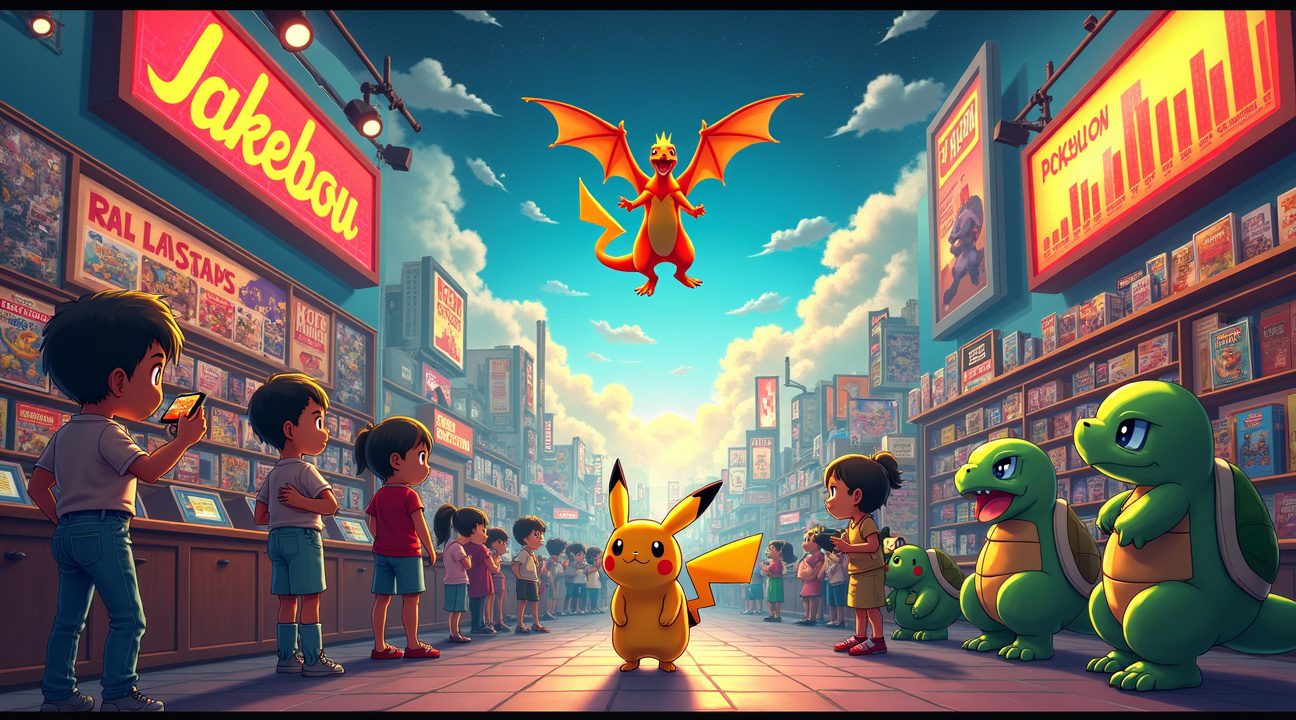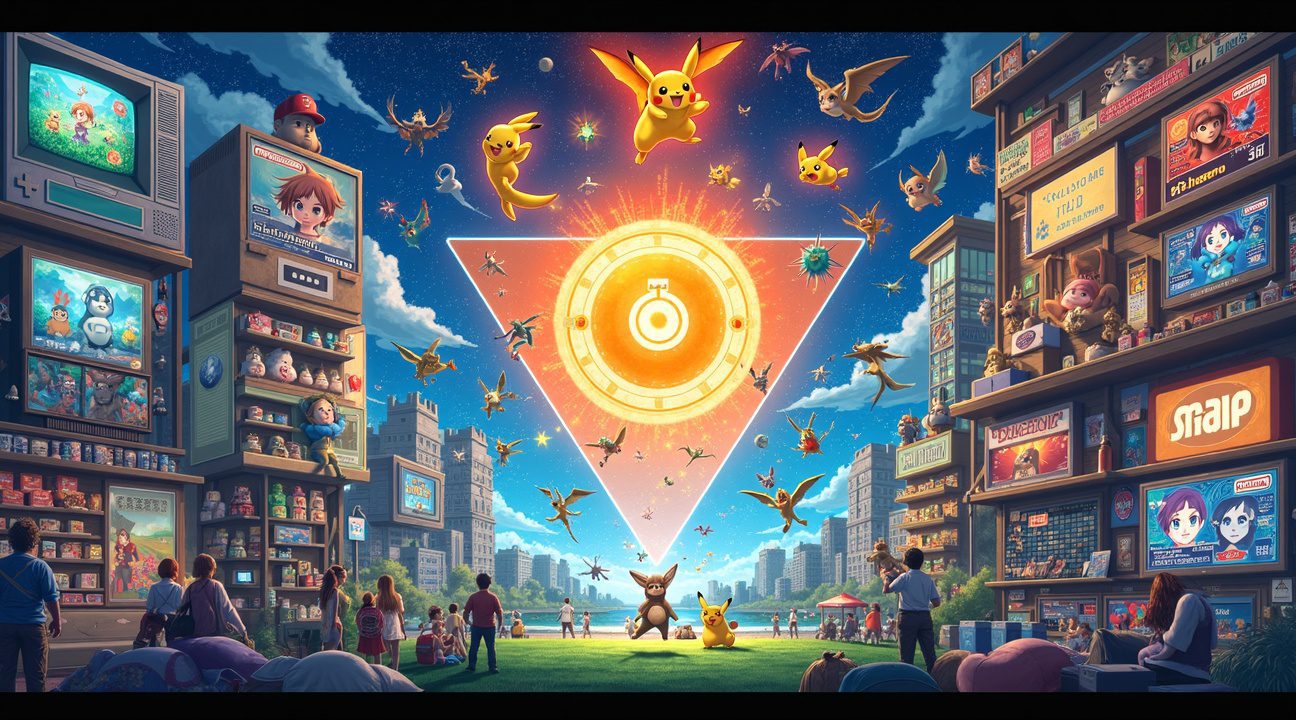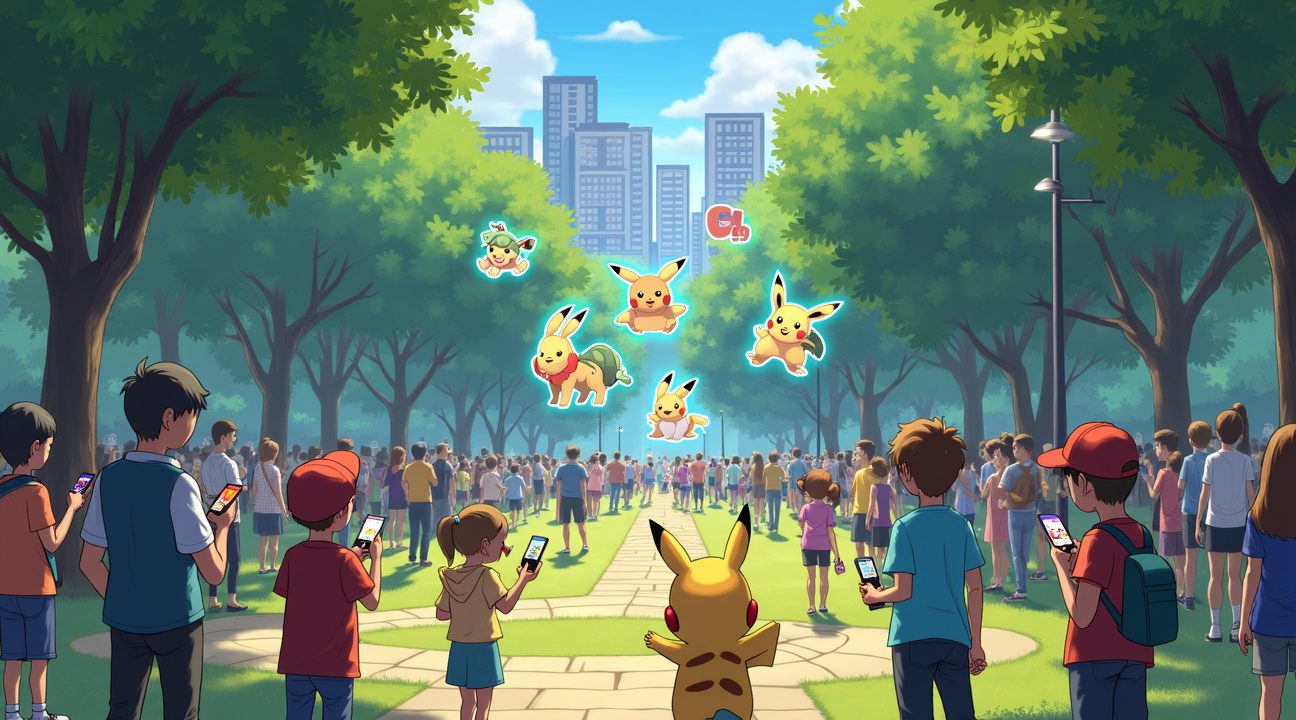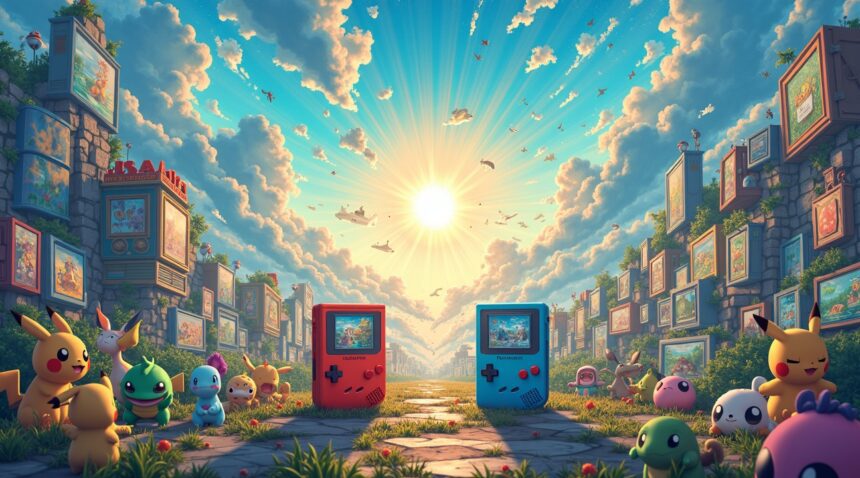The classic Pokémon games launched a gaming revolution in 1996 that fundamentally changed portable entertainment. These titles established one of the most enduring fan bases in gaming history. Their explosive debut sold over 1 million units in Japan. Eventually, they achieved 31.38 million copies worldwide. Red, Green, and Blue didn’t just capture players’ imaginations—they created a multimedia empire. This empire continues to break sales records and attract new generations of trainers nearly three decades later.
Key Takeaways
- The original Pokémon Red, Green, and Blue games achieved record-breaking sales of 31.38 million units globally, becoming the best-selling entries in the franchise and demonstrating unprecedented commercial success for portable gaming.
- The franchise’s innovative “gotta catch ’em all” concept and social trading mechanics created an addictive gameplay loop that transcended traditional gaming boundaries and established lasting cultural appeal.
- Pokémon successfully expanded beyond video games into a multimedia empire encompassing anime, movies, trading cards (75 billion printed), and merchandise, creating multiple revenue streams that reinforced each other.
- Modern entries like Sword/Shield (26.6 million units) and Scarlet/Violet (26.38 million) prove the franchise maintains its commercial dominance across generations, with total game sales exceeding 489 million units as of 2025.
- The series has consistently adapted to new technologies from Game Boy link cables to mobile AR in Pokémon GO, while preserving core mechanics, ensuring relevance across multiple console generations and attracting both nostalgic players and newcomers.
Record-Breaking Sales Figures That Changed Gaming Forever
I’ve witnessed gaming history unfold through remarkable sales figures that demonstrated the unprecedented power of Pokémon Red, Green, and Blue. These titles didn’t just capture players’ imaginations—they revolutionized an entire industry with numbers that still impress today.
Lightning-Fast Success in Japan
The original Pokémon games burst onto Japan’s gaming scene with explosive momentum, achieving 1.04 million units sold during their debut year. This remarkable start gained even more traction in 1997, when sales soared to 3.65 million units, establishing them as Japan’s bestselling game titles and even surpassing the legendary Final Fantasy VII.
By 2000, the combined sales revenue from these games and the trading card game in Japan exceeded $4 billion—a staggering figure that highlighted how Charizard and its companions had captured an entire generation. I find it fascinating that these numbers represented more than just game sales; they marked the birth of a multimedia empire that would span decades.
Global Dominance and Cultural Impact
The international expansion of Pokémon delivered equally impressive results across multiple markets. In the United States, Red and Blue became the fastest-selling Game Boy games ever recorded, moving over 200,000 copies within just two weeks of their 1998 launch. This momentum continued throughout the year, reaching 4 million copies sold by December—numbers that demonstrated America’s immediate embrace of pocket monster collecting.
European markets responded with similar enthusiasm, particularly France, where over 2.5 million units sold within one year. Total European sales surpassed $120 million by the end of 1999, equivalent to significantly higher figures in today’s currency. The worldwide phenomenon had clearly transcended cultural boundaries.
These achievements culminated in the original generation reaching 31.38 million units sold globally by December 2024, cementing their status as the best-selling Pokémon games worldwide. I believe these figures tell a story that extends far beyond simple commercial success—they represent the creation of a fan base that would remain devoted for generations. The numbers prove that sometimes, the right combination of innovation, accessibility, and imagination can create passionate communities that endure long after the initial excitement fades.

The Birth of a Revolutionary Gaming Concept in 1996
The gaming industry experienced a seismic shift when Pokémon Red and Green launched in Japan on February 27, 1996. These groundbreaking titles, developed by Game Freak in collaboration with Nintendo, introduced an entirely new concept that would reshape portable gaming forever. I’ve observed how this initial release laid the foundation for what would become one of the most enduring entertainment franchises in history.
Satoshi Tajiri’s vision brought something unprecedented to the Nintendo Game Boy platform. His childhood fascination with collecting insects directly influenced the core mechanics of catching and cataloging creatures throughout the game world. The concept seemed deceptively simple: players would venture into tall grass, encounter wild creatures called Pokémon, and attempt to capture them using special devices called Poké Balls.
The gameplay loop that emerged from this concept proved absolutely magnetic. Players found themselves compelled to “catch ’em all,” a phrase that would become synonymous with the franchise. Each captured Pokémon could be trained, evolved, and used in strategic battles against other trainers. This created an addictive cycle that kept players engaged for countless hours.
Technical Innovation Meets Creative Inspiration
The technical capabilities of the Game Boy played a crucial role in bringing Tajiri’s vision to life. The handheld console’s link cable feature became integral to the game’s design philosophy. I recognize how this connectivity option transformed what could have been a solitary experience into a social phenomenon.
The decision to release two versions simultaneously – Red and Green – leveraged this technical feature brilliantly. Each version contained exclusive Pokémon that couldn’t be found in the other, creating an immediate incentive for trading. Players needed to connect their Game Boy systems and exchange creatures to complete their collections.
Game Freak’s development approach demonstrated remarkable foresight in understanding portable gaming’s potential. The studio recognized that players wanted experiences they could carry anywhere, yet still share with friends. This balance between personal progression and social interaction became a cornerstone of the franchise’s appeal.
The original 151 Pokémon each possessed unique characteristics, abilities, and evolutionary paths. This diversity ensured that every player could develop their own preferred team composition and battling strategy. Some trainers gravitated toward powerful, dragon-type creatures, while others preferred the charm of classic starter Pokémon like Charmander, Squirtle, and Bulbasaur.
Nintendo’s marketing strategy complemented the innovative gameplay perfectly. The company positioned Pokémon as more than just another video game – it was an entire universe waiting to be explored. This approach would prove prescient as the franchise expanded into anime, movies, trading cards, and countless other media formats.
The impact of these original games extended far beyond their initial sales figures. They established gameplay mechanics that remain virtually unchanged in modern entries. The turn-based battle system, type effectiveness chart, and progression through gym leaders created a template that continues to resonate with new generations of players.
I’ve witnessed how the 1996 release created a ripple effect throughout the gaming industry. Other developers began exploring similar creature-collecting concepts, though none achieved the same cultural penetration. The success proved that portable gaming could support complex, lengthy adventures that rivaled home console experiences.
The collaborative effort between Game Freak and Nintendo also set a precedent for how smaller development studios could partner with major publishers to create global phenomena. This relationship model influenced countless other successful gaming partnerships in subsequent decades.
Looking back at the revolutionary concept introduced in 1996, it’s clear that Pokémon Red and Green accomplished something extraordinary. They transformed a simple idea about collecting creatures into a gaming experience that transcended traditional boundaries. The foundation they established continues to support ongoing adventures and innovations within the franchise, proving that truly great game design can endure for generations.
From Video Games to Global Pop Culture Domination
The initial success of Pokémon Red and Blue triggered an unprecedented multimedia expansion that transformed a simple Game Boy title into one of the most recognizable brands worldwide. This transformation didn’t happen by accident—each new medium reinforced the core experience while attracting entirely new audiences who might never have picked up a handheld console.
The animated series launched just months after the games hit Japan, introducing Ash Ketchum and Pikachu to television screens globally. This strategic timing allowed the show to capitalize on the games’ momentum while creating its own narrative that could appeal to broader demographics. Children who weren’t yet ready for complex RPG mechanics could still engage with the colorful characters and straightforward adventure stories. The series also solved a fundamental problem for Nintendo: how to maintain interest between game releases.
Building Multiple Revenue Streams
The franchise’s expansion strategy created several interconnected revenue streams that each supported the others:
- Trading cards provided a physical collectible element that extended gameplay beyond screen time
- Movies offered premium content experiences that drove ticket sales and merchandise opportunities
- Spin-off games explored different genres while maintaining the core brand identity
- Merchandise created everyday touchpoints with the franchise through toys, clothing, and accessories
The Pokémon Trading Card Game deserves particular recognition for its explosive growth trajectory. With 75 billion cards printed by 2025, the physical card game has become a phenomenon in its own right. The fact that 13.6% of all cards were printed in just the last fiscal year demonstrates that this isn’t a declining trend—it’s experiencing renewed vigor decades after launch.
Game sales numbers tell an equally impressive story. The franchise has moved 489 million games worldwide across both mainline and spin-off titles as of May 2025. This figure encompasses everything from the original Red and Blue through modern entries and experimental titles like Pokémon Sleep. Each release benefits from the established brand recognition while potentially introducing new mechanics or approaches.
The franchise’s cultural impact extends far beyond sales figures. Charizard’s popularity exemplifies how individual Pokémon have become cultural touchstones that transcend their original medium. Similarly, recent developments like Ash becoming world champion generate headlines and social media discussions that keep the franchise relevant in contemporary conversations.
Movies provided another crucial expansion vector, offering cinematic experiences that could attract casual fans while rewarding dedicated players with deeper lore. The success of live-action adaptations, including ongoing projects like Detective Pikachu’s sequel, proves the brand’s versatility across different storytelling formats.
The persistence factor can’t be overstated. While most video game franchises experience natural decline cycles, Pokémon has maintained relevance through constant reinvention and strategic media presence. The brand helped sustain Game Boy hardware sales well beyond typical console lifecycles, proving that compelling software could extend hardware viability indefinitely.
This multimedia approach also created multiple entry points for new fans. Someone might discover Pokémon through cards, anime, or even viral incidents like Pokémon GO confrontations, then gradually explore other aspects of the franchise. Each medium serves as both entertainment and marketing for the others, creating a self-sustaining ecosystem of content and engagement.
The success demonstrates how thoughtful brand extension can transform a single gaming concept into a lasting cultural institution. Rather than simply porting games to different platforms, the franchise created genuinely different experiences that shared common DNA while appealing to distinct audiences and consumption patterns.

Evolution Through Mobile Gaming and Modern Technology
The franchise reached an entirely new pinnacle in 2016 with Pokémon GO’s groundbreaking launch. This mobile sensation didn’t just capture existing fans—it created a cultural phenomenon that brought augmented reality gaming into mainstream consciousness. I witnessed players of all ages exploring parks, landmarks, and city streets with their phones, hunting for virtual creatures overlaid on real-world locations.
Pokémon GO’s success transformed mobile gaming expectations and became one of the world’s top-grossing mobile games. The title demonstrated how classic gameplay mechanics could evolve through modern technology without losing their core appeal. Players could finally experience the childhood dream of finding Pokémon in their actual neighborhoods, bridging the gap between fantasy and reality in ways the original Game Boy titles could never achieve.
Record-Breaking Modern Releases
Recent console releases have shattered sales expectations while maintaining the series’ fundamental charm. Pokémon Sword/Shield achieved remarkable success with 26.6 million units sold, proving that traditional RPG mechanics still resonate with contemporary audiences. Pokémon Scarlet/Violet followed with equally impressive numbers, reaching 26.38 million units worldwide as of 2024.
These figures place both titles among the top five best-selling entries in the series’ history. The success stems from several key factors that modern developers have refined over decades:
- Enhanced visual storytelling that brings creatures to life with unprecedented detail
- Streamlined mechanics that welcome newcomers while satisfying veteran trainers
- Online connectivity features that foster global community engagement
- Regular content updates that extend gameplay longevity
Enduring Brand Legacy Across Generations
What sets Pokémon apart from other gaming franchises lies in its remarkable ability to maintain relevance across multiple console generations. Even 27 years after the original Red/Blue release, classic titles continue ranking among all-time best-selling console games. This longevity reflects both powerful nostalgia and genuine new-player appeal.
I’ve observed how parents introduce children to the same games they played decades ago, creating shared experiences that transcend generational boundaries. The franchise’s adaptability shows in how it embraces new technology—from Pokémon Sleep’s innovative sleep-tracking mechanics to augmented reality features—without abandoning core elements that made the originals special.
Modern Pokémon games benefit from technological advances that weren’t possible during the Game Boy era. Enhanced graphics, online trading capabilities, and sophisticated AI create richer experiences while preserving the fundamental “gotta catch ’em all” mentality. The franchise continues attracting new generations while satisfying long-term fans who remember Ash’s championship journey from the beginning.
This strategic balance between innovation and tradition explains why Pokémon maintains its position as a dominant force in gaming culture. Each new release builds upon established foundations while introducing fresh elements that keep the experience exciting for both returning players and curious newcomers discovering the franchise for the first time.

The Numbers Behind Gaming’s Most Enduring Franchise
I find it remarkable how Pokémon has maintained its position as one of gaming’s most commercially successful franchises, with sales figures that demonstrate consistent appeal across multiple generations. The original Red/Green/Blue trilogy achieved an impressive 31.05 million units sold, establishing the foundation for what would become a gaming phenomenon that continues to break records today.
Recent entries have proven the franchise’s staying power, with Sword/Shield reaching 26.04 million units and the newest Scarlet/Violet titles achieving 26.38 million units sold. These numbers reflect not just nostalgia-driven purchases but genuine excitement for fresh content and innovation within the established formula. The sustained momentum becomes even more impressive when considering that Pokémon added 9 million units in sales in the past year alone, demonstrating that the fanbase continues to expand rather than simply maintain its existing numbers.
Record-Breaking Sales and Future Projections
The franchise’s commercial dominance positions it among gaming’s elite, with total sales surpassing 489 million games sold as of May 2025. These figures place Pokémon in direct competition with other legendary franchises like Mario and Call of Duty. The upcoming Pokémon Legends: Z-A is projected to boost sales further, capitalizing on the positive reception of the Legends formula that successfully blended traditional mechanics with fresh gameplay elements.
What sets these sales figures apart is their consistency across different gaming eras and technological shifts. From the original Game Boy releases to modern Switch titles, each generation has found ways to attract both returning fans and newcomers. The commercial success reflects deeper cultural and technological evolutions that have kept the franchise relevant across changing gaming landscapes.
I’ve observed how the series has adapted to new platforms while maintaining core appeal, whether through enhanced graphics in recent entries or innovative features like raids in Scarlet and Violet. The fact that Charizard remains popular decades after its debut shows how character design and storytelling transcend technological limitations.
The franchise’s ability to generate excitement extends beyond traditional gaming metrics, with cultural moments like Ash becoming world champion creating renewed interest in both animated content and games. Even unexpected developments like Detective Pikachu 2’s potential development demonstrate how the brand maintains relevance across multiple entertainment mediums.
These sales achievements represent more than commercial success—they reflect a franchise that has successfully evolved while honoring its origins, creating lasting connections with players across generational lines and establishing benchmarks that few gaming properties can match.
Sources:
Statista: “All-time best-selling Pokémon games 2025”
My Nintendo News: “Pokemon series has now sold over 489 million software units worldwide”
Wikipedia: “Pokémon Red, Blue, and Yellow”, “Pokémon (video game series)”
Bulbapedia: “User:Torpoleon/List of Pokémon games by sales figures”
GamesRadar+: “After 28 years, Pokemon Red and Green have been dethroned as the best-selling Pokémon games in Japan”
Install Base/Serebii: “The Pokémon Company reveals new sales numbers: 489 million games, 75 billion cards”


